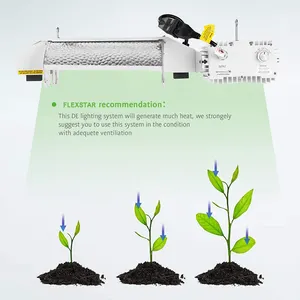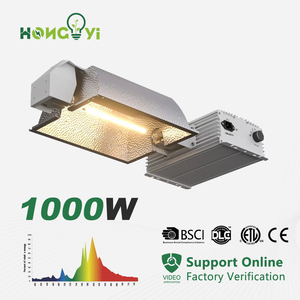(1923 products available)





































































































































































There are two types of 1000W ballasts: magnetic and digital or electronic. The two serve the same purpose but differ in their functionalities.
Magnetic 1000W Ballast
A magnetic 1000W ballast is a device used to regulate the current in a high-intensity discharge (HID) lamp, especially in 1000-watt metal halide or high-pressure sodium lights. It is called magnetic because it uses electromagnetic coils to control the voltage and current supplied to the lamp. The coils are usually made of copper wire, which is wound around a core of magnetic material, typically iron. This type of ballast is known for its simplicity, reliability, and durability. However, it is also relatively heavier and has a lower energy efficiency than electronic ballasts.
Digital or Electronic 1000W Ballast
An electronic or digital 1000w ballast is a device used to regulate and control the operation of high-intensity discharge (HID) lamps, particularly 1000-watt metal halide or high-pressure sodium lamps. Unlike magnetic ballasts, electronic ballasts use semiconductor components to control the electrical current flowing to the lamp. It is called electronic because it uses electronic circuitry, specifically capacitors, transistors, and inductors, to control the voltage and current supplied to the lamp. Electronic ballasts are known for their higher efficiency, lighter weight, and ability to provide better lamp control and operation. They also have a reputation for producing less noise and generating less heat compared to magnetic ballasts.
A 1000w ballast is a device used to regulate the current flow in high-intensity discharge or metal halide lamps. The following are its features and functions:
Voltage Regulation
One key function of a 1000w metal halide ballast is regulating the voltage to the lamp. It ensures the lamp receives a stable voltage level, preventing fluctuations that could cause it to fail or flicker. Stable voltage levels also promote optimal brightness and efficient energy consumption.
Current Regulation
Another important function of the magnetic ballast is to ensure proper current flow to the lamp. Once the lamp ignites, the ballast maintains its current flow. This consistent current flow ensures the lamp remains lit, providing a reliable source of lighting.
Arc Stabilization
Once the lamp ignites, the 1000w HPS ballast helps stabilize the arc between the electrodes. Stabilizing the arc prolongs the lamp's life, ensuring it serves for extended periods. The arc stabilization feature also ensures the lamp maintains consistent brightness. This is especially important in areas where consistent lighting is needed, such as streets and highways.
Thermal Protection
Thermal protection is an important function of the 1000w ballast. It protects the ballast and lamp from overheating. The thermal protection feature ensures the ballast and lamp maintain a stable temperature, preventing them from burning out. It also ensures the lamp has a long lifespan by preventing overheating, which could cause the electrodes to wear out quickly.
Ignition Assistance
The 1000w metal halide ballast helps ignite the lamp by providing it with a high voltage. High voltage is needed to create an arc between the lamp's electrodes. Once the arc is created, the lamp will light up and produce a bright glow.
Electromagnetic Interference
Electromagnetic interference is a common problem in lighting systems.Fortunately, the electromagnetic ballast can help reduce electromagnetic interference. It does this by controlling the electromagnetic fields within the lighting system. Reduced electromagnetic interference ensures the lighting system works efficiently.
Power Factor Correction
Power factor correction is an important function of the 1000w HPS ballast. It improves the power factor of the lighting system, making it more efficient. A good power factor means that more electrical power is used to produce light, which is beneficial to businesses.
There are several scenarios in which a 1000w ballast is used, including:
Horticulture
Ballasts are often used with high-intensity discharge (HID) grow lights for horticultural applications. For instance, metal halide (MH) and high-pressure sodium (HPS) lights are used in indoor farms and greenhouses. A 1000w metal halide ballast is essential for lighting large planting areas. They help regulate the light's stability and temperature, promoting healthy plant growth. Additionally, they prevent light fluctuations that can stress plants, hence improving yield.
Commercial Lighting
A 1000w ballast is commonly used for lighting in warehouses, retail stores, and parking garages. It offers illumination for large spaces, creating a safe and productive environment. For instance, in a warehouse, the magnetic or electronic ballasts provide bright, consistent light. This minimizes flickering and reduces noise interruptions. Also, they are energy efficient, reducing operational costs. They are also easy to maintain and replace, ensuring the lighting system functions optimally.
Sports Lighting
These ballasts are applicable in large sports facilities, such as stadiums and arenas. They provide stable and bright lighting for outdoor and indoor sporting activities. The ballasts ensure the bulbs produce consistent brightness. This minimizes the risk of light fluctuation, which can distract athletes and spectators. Additionally, they provide high color rendering. This allows proper visibility for sports activities and accurate viewing for spectators.
Event Lighting
1000w ballasts are commonly used in temporary lighting setups for large events and concerts. They offer stable and bright light for a large area. This ensures all attendees view the events clearly. They also provide consistent color temperature and rendering. This improves the quality of light for illumination and aesthetic purposes, creating an ambiance for the event. Additionally, they are reliable and easy to maintain, ensuring the lighting system functions optimally during the events.
High-End Residential Lighting
A 1000w ballast is used for lighting in large luxury homes. It provides stable and bright light for interior and exterior illumination. This improves visibility and creates a welcoming environment. Additionally, it offers light with minimal flicker. This is important for areas like home offices, where distractions can hamper productivity. Also, the electronic ballasts are energy efficient, reducing overall energy consumption.
It is necessary to consider several factors when choosing a 1000w ballast for HPS or MH light. Here are some of them:
Type of bulb
The choice of bulb determines the choice of a compatible ballast. Growers should choose a ballast that is compatible with the type of bulb they intend to use. An HPS bulb needs an HPS ballast while an MH bulb requires an MH ballast. A convertible ballast can be used with both bulbs.
Watts
Ballasts are available in different wattages. A 1000w ballast is suitable for larger growing areas. For smaller grow areas, lower wattage ballasts are more than sufficient.
Cool running
A good choice of ballast runs cool. Cool running ballasts help prevent heat stress in plants. They also prevent the risk of overheating and burning.
Reliability
Growers should choose a reliable 1000w ballast. A reliable ballast provides consistent performance. It ensures the safety of the plants and the grow space.
Quality of construction
A good choice of 1000w ballast has quality construction. It features a durable casing that protects the internal components. Such ballasts can withstand the rigors of indoor gardening.
Compatibility
The compatibility of a ballast with other grow room equipment is important. Growers should choose a ballast that is compatible with their existing equipment. This includes reflectors, lamps, and power supplies.
Ease of use
Growers should choose a 1000w ballast that is easy to use. Such a ballast has simple setup and operating instructions. It also has easy-to-follow troubleshooting guidelines.
Adjustability
A good choice of 1000w ballast offers adjustability. This allows users to customize the output to meet the specific needs of their plants. Adjustable ballasts can vary light intensity. This comes in handy during different growth stages of the plants.
Dimming option
Some ballasts support dimming. This feature reduces light intensity when full power is not needed. Dimming options can be used to save energy and reduce heat output.
Smart features
High-end grow room owners can invest in 1000w ballasts with smart features. Such ballasts come with LCD screens that display vital information at a glance. They have remote control options for easy operation. Some can send alerts in case of malfunctions.
Q1. What are the disadvantages of using a magnetic 1000w ballast?
A1. Magnetic ballasts must be installed correctly. Otherwise, they can cause flickering lights and overheating. They also produce more noise than electronic ballasts.
Q2. How can one maintain a ballast?
A2. Ballasts do not need much maintenance. But it is important to check it regularly to ensure it is working properly. The wiring and connections should be checked for any signs of damage or overheating. The temperature should be checked as well since high temperatures can damage the ballast.
Q3. How long does a good ballast last?
A3. Good ballasts can last up to 20 years. However, the actual lifespan will depend on several factors, including how it is maintained and the environmental conditions.
Q4. Do ballasts need to be replaced?
A4. It is possible for a ballast to fail over time. If the ballast fails, the lamp won't light up. In this case, the ballast will need to be replaced.
Q5. Does a good ballast mean better light?